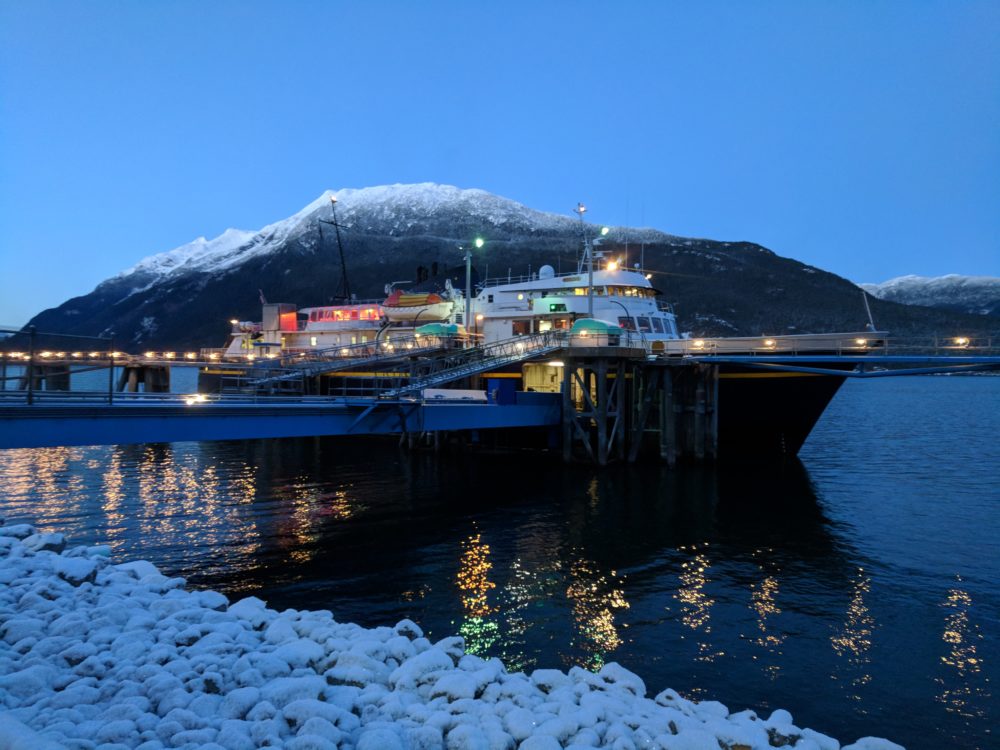
The LeConte docking in Haines earlier this winter. (Berett Wilber)
It’s been ten days since a ferry arrived in Haines or Skagway. And while that might be the service norm in other Southeast communities, for people in Upper Lynn Canal who plan their lives and trips around reliable service several times a week, it’s frustrating and leaves them wondering why.
When Upper Lynn Canal residents woke up to whitecaps on Friday, it wasn’t much of a surprise when the M/V LeConte’s trip from Juneau to Haines was canceled. Aurah Landau, with the Department of Transportation, says there’s not one threshold factor that keeps a ferry at the dock: the Captain makes the call.
“To date in Lynn Canal, the LeConte has been canceled more than usual. There has been unexpected bad weather, very high seas, lots of icing conditions this winter.”
A double whammy of bad weather and mechanical issues have plagued Southeast Alaska’s ferries this week. Two of the mainliners, the M/V Malaspina, and the M/V Columbia, are out for repairs.
The M/V LeConte was the only ferry up and running in Southeast Alaska. Or, actually not running — at least, not here. First weather, then steering issues, and now weather again, have kept the ferry away from Northern Lynn Canal.
Ed Liske works with the National Weather Service in Juneau.
“It’s actually currently blowing storm force in the canal right now, right around — 50 knots at the moment? There’s also been a lot of freezing spray here, as well,” he says.
Cold air is getting pushed down from the Arctic has created lots of wind — which is actually pretty normal here.
“It might be a little unusual for how long it’s lasted,” he says. “Maybe one or two calmer periods, but for the most part it’s been gale force or higher in Lynn Canal, out of the North, for the last week.”
But even if the weather isn’t new, there’s no question the Marine Highway is shorter on resources than it used to be. $29 million has been cut from the ferry budget since 2013, Landau says.
“Due to those cuts, the Alaska Marine Highway is running fewer service weeks, has sold a ship, permanently taken another ship out of service, and has laid off employees.”
The LeConte is one of the fleet’s smaller vessels: it often gets canceled for safety reasons when big, cold winds kick up icy waves. So why is it servicing an area in Southeast that Ed Liske describes as “a wind tunnel?”
“Well, the Marine Highway system, when it’s scheduling ships, does have to take into account the length of time crew members can stay on board a ship,” Landau says. “And it does factor into how the ships can move throughout communities.”
For example, the LeConte wasn’t always a day boat: it used to run the Inside Passage 24-hours a day between Petersburg and Juneau, stopping in at Hoonah, Angoon, Kake, Pelican, Sitka, and Tenakee Springs.
But it ran aground in 2004 and almost sank in Peril Strait with 31 people aboard. The National Transportation Safety Board investigated. It concluded the accident was due to human error: fatigue. The chief mate set a course that steered the ferry straight into a reef, and neither he nor the ship’s master noticed.
The Coast Guard did its own investigation and concluded running through many small ports, in complex waters, 24-hours a day had created serious sleep and stress problems for the crew.
The Coast Guard ordered the ferry’s work schedule be changed. The LeConte could run Lynn Canal and still meet its requirement of homeporting in Juneau every night.
Two new ferries, the Alaska Class Ferries, are being built to take over the route in 2019. They’ll have the same schedule as the LeConte, but not the same build, Landau says.
“They’re longer, wider, deeper, heavier, so they can handle much higher wind and seas.”
In the meantime, the highway’s flagship, the M/V Columbia will be back in service this weekend, so even if the wind continues, Upper Lynn Canal will probably see a ferry soon.









Forget about Alaska class ferry . . We need Upper Lynn Canal class ferry